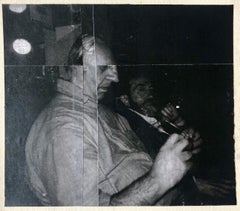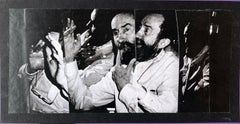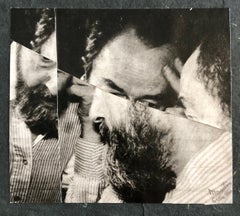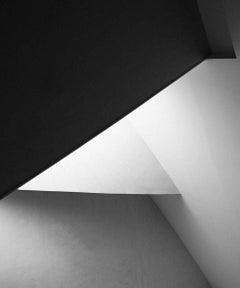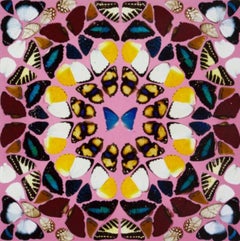Martin Sumers Art
to
3
Overall Width
to
Overall Height
to
3
2
3
3
3
3
6
9,478
2,688
1,375
1,361
3
Artist: Martin Sumers
Vintage Abstract Expressionist Hyman Bloom Photo Collage Assemblage Photograph
By Martin Sumers
Located in Surfside, FL
This is a unique original collage, decoupage style of Jiri Kolar, This is an exceptional artwork which was part of a collaboration between Hyman Bloom and fellow artist and his very ...
Category
1990s Modern Martin Sumers Art
Materials
Paper, Photographic Paper
Vintage Abstract Expressionist Hyman Bloom Photo Collage Assemblage Photograph
By Martin Sumers
Located in Surfside, FL
This is a unique original collage, decoupage style of Jiri Kolar, This is an exceptional artwork which was part of a collaboration between Hyman Bloom and fellow artist and his very ...
Category
20th Century Modern Martin Sumers Art
Materials
Paper, Photographic Paper
Vintage Abstract Expressionist Hyman Bloom Photo Collage Assemblage Photograph
By Martin Sumers
Located in Surfside, FL
This is a unique original collage, decoupage style of Jiri Kolar, This is an exceptional artwork which was part of a collaboration between Hyman Bloom and fellow artist and his very ...
Category
1990s Modern Martin Sumers Art
Materials
Paper, Photographic Paper
Related Items
Heart 02
By Kim Holtermand
Located in New York, NY
ABOUT THIS PIECE: Danish photographer Kim Høltermand photographed the Herning Art Museum in Jutland, Denmark. He is known for his moody, quiet photos that show public spaces before t...
Category
2010s Martin Sumers Art
Materials
Photographic Paper
Beneficence
By Damien Hirst
Located in New York, NY
A superb impression of this color giclée print on wove paper. Signed and numbered 20/50 in pencil by Hirst. Published by Other Criteria, London.
Category
2010s Modern Martin Sumers Art
Materials
Color, Giclée
"Mirrors" Black & White Photography 39" x 39" inch Edition 1/3 by Olha Stepanian
By Olha Stepanian
Located in Culver City, CA
"Mirrors" Black & White Photography 39" x 39" inch Edition 1/3 by Olha Stepanian
Printed on Epson Professional Paper
Signed and numbered by the artist
Not framed. Ships in a tube....
Category
21st Century and Contemporary Surrealist Martin Sumers Art
Materials
Photographic Paper
"Real 2" Black & White Photography 24" x 24" in Edition 1/15 by Olha Stepanian
By Olha Stepanian
Located in Culver City, CA
"Real 2" Black & White Photography 24" x 24" in Edition 1/15 by Olha Stepanian
Printed on Epson Professional Paper
Signed and numbered by the artist
Not framed. Ships in a tube.
...
Category
21st Century and Contemporary Surrealist Martin Sumers Art
Materials
Photographic Paper
$1,400
H 24 in W 24 in D 0.1 in
“The Winter Ball” 1988
Located in Austin, TX
Poster Size: 23.5 x 16.5 in.
Vintage Gold Leaf Frame Size: 23.5 x 16.5 in.
Signed and inscribed in gold marker, bottom right
A poster for "The Winter Ball 1988" in Houston, Texas, p...
Category
1980s Pop Art Martin Sumers Art
Materials
Paper, Lithograph, Offset
Guggenheim Museum - American Architecture Museum Black and White Photograph
Located in Brighton, GB
Guggenheim Museum - American Architecture Museum Black and White Photograph
The recognisable Guggenheim Museum was designed by American architect Frank Lloyd Wright, and is now a UN...
Category
20th Century Modern Martin Sumers Art
Materials
Photographic Paper, Black and White, Silver Gelatin
$381
H 16 in W 20 in D 0.1 in
"Unicorn Moebius II" - Trial Proof Lithograph in Ink on Laid Paper
By Bruce Weinberg
Located in Soquel, CA
"Unicorn Moebius II" - Trial Proof Lithograph in Ink on Laid Paper
High contrast, multi-layer etching by Bruce Weinberg (American, 1942-1994). A moebius strip is shown against a dar...
Category
1980s American Modern Martin Sumers Art
Materials
Laid Paper, Lithograph
$1,850
H 28.5 in W 34.25 in D 1.25 in
"Nobility" 180/300 Signed Color Serigraph of Abstract Horse and Woman with Lute
By Tiefeng Jiang
Located in Austin, TX
Serigraph on paper
Page Size: 12 x 12 in.
Gold Leaf Frame Size: 21 x 21 in.
Hand Signed, bottom right in black marker
Hand Numbered, bottom left in black marker "180/300"
This strik...
Category
1990s Pop Art Martin Sumers Art
Materials
Archival Paper, Screen
Original Stone Garden - psychedelic pop-art 1960s vintage poster
Located in Spokane, WA
The original Stone Garden vintage psychedelic 1960s poster is in excellent condition.
The artist is Wilfred Satty (1939 – 1982). German-born collage artist and graphic designer ...
Category
1960s Modern Martin Sumers Art
Materials
Lithograph
$595
H 35 in W 24 in D 0.2 in
Heart 03
By Kim Holtermand
Located in New York, NY
ABOUT THIS PIECE: Danish photographer Kim Høltermand photographed the Herning Art Museum in Jutland, Denmark. He is known for his moody, quiet photos that show public spaces before t...
Category
2010s Martin Sumers Art
Materials
Photographic Paper
Composition (Vallier 102), Les Paroles Transparentes, Georges Braque
By Georges Braque
Located in Southampton, NY
Lithograph on Auvergne du Moulin Richard de Bas filigrané paper. Inscription: Watermarked with the artist's signature and unnumbered, as issued. Good condition. Notes: From the folio...
Category
1950s Modern Martin Sumers Art
Materials
Lithograph
$2,796 Sale Price
20% Off
H 17 in W 12.75 in
Galloping Horse - Etching by Jean-Marie Guiny - 2000s
By Jean-marie Guiny
Located in Roma, IT
Galloping Horse is an artwork realized by Jean-Marie Guiny, 2000s.
Etching, Edition 145/160.
40 x 50 cm ; with frame.
Hand signed in the lower right part.
Good condtions!
J...
Category
Early 2000s Modern Martin Sumers Art
Materials
Etching
$375 Sale Price
35% Off
H 15.75 in W 19.69 in D 0.79 in
Previously Available Items
Vintage Abstract Expressionist Hyman Bloom Photo Collage Assemblage Photograph
By Martin Sumers
Located in Surfside, FL
This is a unique original collage, decoupage style of Jiri Kolar, This is an exceptional artwork which was part of a collaboration between Hyman Bloom and fellow artist and his very good friend Martin Sumers. This is pencil signed by Martin Sumers.
Provenance: Acquired from the Sumers estate collection.
Hyman Bloom (March 29, 1913 – August 26, 2009) was a Latvian-born American painter. His work was influenced by his Jewish heritage and Eastern religions as well as by artists including Altdorfer, Grünewald, Caravaggio, Rembrandt, Blake, Bresdin, James Ensor and Chaim Soutine. He first came to prominence when his work was included in the 1942 Museum of Modern Art exhibition "Americans 1942 -- 18 Artists from 9 States". MoMA purchased 2 paintings from the exhibition and Time magazine singled him out as a "striking discovery" in their exhibition review.
His work was selected for both the 1948 and 1950 Venice Biennale exhibitions and his 1954 retrospective traveled from Boston's Institute of Contemporary Art to the Albright Gallery and the de Young Museum before closing out at The Whitney Museum of American Art in 1955. In a 1954 interview with Yale art professor Bernard Chaet, Willem de Kooning indicated that he and Jackson Pollock both considered Bloom to be “America’s first abstract expressionist”, a label that Bloom would disavow. Starting in the mid 1950s his work began to shift more towards works on paper and he exclusively focused on drawing throughout the 1960s, returning to painting in 1971. He continued both drawing and painting until his death in 2009 at the age of 9
Hyman Bloom (né Melamed) was born into an orthodox Jewish family in the tiny Jewish village of Brunavišķi in what is now Latvia, then part of the Russian Empire
At a young age Bloom planned to become a rabbi, but his family could not find a suitable teacher. In the eighth grade he received a scholarship to a program for gifted high school students at the Museum of Fine Arts. He attended the Boston High School of Commerce, which was near the museum. He also took art classes at the West End Community Center, a settlement house. The classes were taught by Harold Zimmerman, a student at the School of the Museum of Fine Arts, who also taught the young Jack Levine at another settlement house in Roxbury. When Bloom was fifteen, he and Levine began studying with a well-known Harvard art professor, Denman Ross, who rented a studio for the purpose and paid the boys a weekly stipend to enable them to continue their studies rather than take jobs to support their families.
He took Bloom and Levine on a field trip to the Museum of Modern Art in New York, where Bloom was impressed by the work of Rouault and Soutine and began experimenting with their expressive painting styles.
In the 1930s Bloom worked sporadically for the Public Works of Art Project and the Federal Art Project (WPA), He shared a studio in the South End with Levine and another artist, Betty Chase. It was during this period that he developed a lifelong interest in Eastern philosophy and music, and in Theosophy.
He first received national attention in 1942 when thirteen of his paintings were included in the Museum of Modern Art (MoMA) exhibition Americans 1942: 18 Artists from 9 States, curated by Dorothy Miller. MoMA purchased two of his paintings from that exhibition, and he was featured in Time magazine. The titles of his paintings in the exhibition reflect some of his recurring themes. Two were titled The Synagogue, another, Jew with the Torah; Bloom was actually criticized by one reviewer for including "stereotypical" Jewish images. He also had two paintings titled The Christmas Tree, and another titled The Chandelier, both subjects he returned to repeatedly. Another, Skeleton (c. 1936), was followed by a series of cadaver paintings in the forties, and The Fish (c. 1936) was one of many paintings and drawings of fish he created over the course of his career.
Bloom was associated at first with the growing Abstract Expressionist movement. Willem de Kooning and Jackson Pollock, who first saw Bloom's work at the MoMA exhibition, considered Bloom "the first Abstract Expressionist artist in America." In 1950 he was chosen, along with the likes of de Kooning, Pollock, and Arshile Gorky, to represent the United States at the Venice Biennale. That same year Elaine de Kooning wrote about Bloom in ARTnews, noting that in paintings such as The Harpies, his work approached total abstraction: "the whole impact is carried in the boiling action of the pigment". In 1951 Thomas B. Hess reproduced Bloom's Archaeological Treasure in his first book, Abstract Painting: Background and American Phase, along with works by Picasso, Pollock, and others. Both de Kooning and Hess remarked on Bloom's expressive paint handling, a key characteristic of Abstract Expressionist painting.
As abstract expressionism dominated the American art world, Bloom became disenchanted with it, calling it "emotional catharsis, with no intellectual basis." In addition, instead of moving to New York to pursue his career, he opted to stay in Boston. As a result he fell out of favor with critics and never achieved the kind of fame that Pollock and others did. He disliked self-promotion and never placed much value on critical acclaim.
Many of Bloom's paintings feature rabbis, usually holding the Torah. According to Bloom, his intentions were more artistic than religious. He began questioning his Jewish faith early in life, and painted rabbis, he claimed, because that was what he knew. Over the course of his career he produced dozens of paintings of rabbis...
Category
1990s Modern Martin Sumers Art
Materials
Paper, Photographic Paper
Vintage Abstract Expressionist Hyman Bloom Photo Collage Assemblage Photograph
By Martin Sumers
Located in Surfside, FL
This is a unique original collage, decoupage style of Jiri Kolar, This is an exceptional artwork which was part of a collaboration between Hyman Bloom and fellow artist and his very good friend Martin Sumers. This is pencil signed by Martin Sumers.
Provenance: Acquired from the Sumers estate collection.
Hyman Bloom (March 29, 1913 – August 26, 2009) was a Latvian-born American painter. His work was influenced by his Jewish heritage and Eastern religions as well as by artists including Altdorfer, Grünewald, Caravaggio, Rembrandt, Blake, Bresdin, James Ensor and Chaim Soutine. He first came to prominence when his work was included in the 1942 Museum of Modern Art exhibition "Americans 1942 -- 18 Artists from 9 States". MoMA purchased 2 paintings from the exhibition and Time magazine singled him out as a "striking discovery" in their exhibition review.
His work was selected for both the 1948 and 1950 Venice Biennale exhibitions and his 1954 retrospective traveled from Boston's Institute of Contemporary Art to the Albright Gallery and the de Young Museum before closing out at The Whitney Museum of American Art in 1955. In a 1954 interview with Yale art professor Bernard Chaet, Willem de Kooning indicated that he and Jackson Pollock both considered Bloom to be “America’s first abstract expressionist”, a label that Bloom would disavow. Starting in the mid 1950s his work began to shift more towards works on paper and he exclusively focused on drawing throughout the 1960s, returning to painting in 1971. He continued both drawing and painting until his death in 2009 at the age of 9
Hyman Bloom (né Melamed) was born into an orthodox Jewish family in the tiny Jewish village of Brunavišķi in what is now Latvia, then part of the Russian Empire
At a young age Bloom planned to become a rabbi, but his family could not find a suitable teacher. In the eighth grade he received a scholarship to a program for gifted high school students at the Museum of Fine Arts. He attended the Boston High School of Commerce, which was near the museum. He also took art classes at the West End Community Center, a settlement house. The classes were taught by Harold Zimmerman, a student at the School of the Museum of Fine Arts, who also taught the young Jack Levine at another settlement house in Roxbury. When Bloom was fifteen, he and Levine began studying with a well-known Harvard art professor, Denman Ross, who rented a studio for the purpose and paid the boys a weekly stipend to enable them to continue their studies rather than take jobs to support their families.
He took Bloom and Levine on a field trip to the Museum of Modern Art in New York, where Bloom was impressed by the work of Rouault and Soutine and began experimenting with their expressive painting styles.
In the 1930s Bloom worked sporadically for the Public Works of Art Project and the Federal Art Project (WPA), He shared a studio in the South End with Levine and another artist, Betty Chase. It was during this period that he developed a lifelong interest in Eastern philosophy and music, and in Theosophy.
He first received national attention in 1942 when thirteen of his paintings were included in the Museum of Modern Art (MoMA) exhibition Americans 1942: 18 Artists from 9 States, curated by Dorothy Miller. MoMA purchased two of his paintings from that exhibition, and he was featured in Time magazine. The titles of his paintings in the exhibition reflect some of his recurring themes. Two were titled The Synagogue, another, Jew with the Torah; Bloom was actually criticized by one reviewer for including "stereotypical" Jewish images. He also had two paintings titled The Christmas Tree, and another titled The Chandelier, both subjects he returned to repeatedly. Another, Skeleton (c. 1936), was followed by a series of cadaver paintings in the forties, and The Fish (c. 1936) was one of many paintings and drawings of fish he created over the course of his career.
Bloom was associated at first with the growing Abstract Expressionist movement. Willem de Kooning and Jackson Pollock, who first saw Bloom's work at the MoMA exhibition, considered Bloom "the first Abstract Expressionist artist in America." In 1950 he was chosen, along with the likes of de Kooning, Pollock, and Arshile Gorky, to represent the United States at the Venice Biennale. That same year Elaine de Kooning wrote about Bloom in ARTnews, noting that in paintings such as The Harpies, his work approached total abstraction: "the whole impact is carried in the boiling action of the pigment". In 1951 Thomas B. Hess reproduced Bloom's Archaeological Treasure in his first book, Abstract Painting: Background and American Phase, along with works by Picasso, Pollock, and others. Both de Kooning and Hess remarked on Bloom's expressive paint handling, a key characteristic of Abstract Expressionist painting.
As abstract expressionism dominated the American art world, Bloom became disenchanted with it, calling it "emotional catharsis, with no intellectual basis." In addition, instead of moving to New York to pursue his career, he opted to stay in Boston. As a result he fell out of favor with critics and never achieved the kind of fame that Pollock and others did. He disliked self-promotion and never placed much value on critical acclaim.
Many of Bloom's paintings feature rabbis, usually holding the Torah. According to Bloom, his intentions were more artistic than religious. He began questioning his Jewish faith early in life, and painted rabbis, he claimed, because that was what he knew. Over the course of his career he produced dozens of paintings of rabbis...
Category
1990s Modern Martin Sumers Art
Materials
Paper, Photographic Paper
Vintage Abstract Expressionist Hyman Bloom Photo Collage Assemblage Photograph
By Martin Sumers
Located in Surfside, FL
This is a unique original collage, decoupage style of Jiri Kolar, This is an exceptional artwork which was part of a collaboration between Hyman Bloom and fellow artist and his very good friend Martin Sumers. This is pencil signed by Martin Sumers.
Provenance: Acquired from the Sumers estate collection.
Hyman Bloom (March 29, 1913 – August 26, 2009) was a Latvian-born American painter. His work was influenced by his Jewish heritage and Eastern religions as well as by artists including Altdorfer, Grünewald, Caravaggio, Rembrandt, Blake, Bresdin, James Ensor and Chaim Soutine. He first came to prominence when his work was included in the 1942 Museum of Modern Art exhibition "Americans 1942 -- 18 Artists from 9 States". MoMA purchased 2 paintings from the exhibition and Time magazine singled him out as a "striking discovery" in their exhibition review.
His work was selected for both the 1948 and 1950 Venice Biennale exhibitions and his 1954 retrospective traveled from Boston's Institute of Contemporary Art to the Albright Gallery and the de Young Museum before closing out at The Whitney Museum of American Art in 1955. In a 1954 interview with Yale art professor Bernard Chaet, Willem de Kooning indicated that he and Jackson Pollock both considered Bloom to be “America’s first abstract expressionist”, a label that Bloom would disavow. Starting in the mid 1950s his work began to shift more towards works on paper and he exclusively focused on drawing throughout the 1960s, returning to painting in 1971. He continued both drawing and painting until his death in 2009 at the age of 9
Hyman Bloom (né Melamed) was born into an orthodox Jewish family in the tiny Jewish village of Brunavišķi in what is now Latvia, then part of the Russian Empire
At a young age Bloom planned to become a rabbi, but his family could not find a suitable teacher. In the eighth grade he received a scholarship to a program for gifted high school students at the Museum of Fine Arts. He attended the Boston High School of Commerce, which was near the museum. He also took art classes at the West End Community Center, a settlement house. The classes were taught by Harold Zimmerman, a student at the School of the Museum of Fine Arts, who also taught the young Jack Levine at another settlement house in Roxbury. When Bloom was fifteen, he and Levine began studying with a well-known Harvard art professor, Denman Ross, who rented a studio for the purpose and paid the boys a weekly stipend to enable them to continue their studies rather than take jobs to support their families.
He took Bloom and Levine on a field trip to the Museum of Modern Art in New York, where Bloom was impressed by the work of Rouault and Soutine and began experimenting with their expressive painting styles.
In the 1930s Bloom worked sporadically for the Public Works of Art Project and the Federal Art Project (WPA), He shared a studio in the South End with Levine and another artist, Betty Chase. It was during this period that he developed a lifelong interest in Eastern philosophy and music, and in Theosophy.
He first received national attention in 1942 when thirteen of his paintings were included in the Museum of Modern Art (MoMA) exhibition Americans 1942: 18 Artists from 9 States, curated by Dorothy Miller. MoMA purchased two of his paintings from that exhibition, and he was featured in Time magazine. The titles of his paintings in the exhibition reflect some of his recurring themes. Two were titled The Synagogue, another, Jew with the Torah; Bloom was actually criticized by one reviewer for including "stereotypical" Jewish images. He also had two paintings titled The Christmas Tree, and another titled The Chandelier, both subjects he returned to repeatedly. Another, Skeleton (c. 1936), was followed by a series of cadaver paintings in the forties, and The Fish (c. 1936) was one of many paintings and drawings of fish he created over the course of his career.
Bloom was associated at first with the growing Abstract Expressionist movement. Willem de Kooning and Jackson Pollock, who first saw Bloom's work at the MoMA exhibition, considered Bloom "the first Abstract Expressionist artist in America." In 1950 he was chosen, along with the likes of de Kooning, Pollock, and Arshile Gorky, to represent the United States at the Venice Biennale. That same year Elaine de Kooning wrote about Bloom in ARTnews, noting that in paintings such as The Harpies, his work approached total abstraction: "the whole impact is carried in the boiling action of the pigment". In 1951 Thomas B. Hess reproduced Bloom's Archaeological Treasure in his first book, Abstract Painting: Background and American Phase, along with works by Picasso, Pollock, and others. Both de Kooning and Hess remarked on Bloom's expressive paint handling, a key characteristic of Abstract Expressionist painting.
As abstract expressionism dominated the American art world, Bloom became disenchanted with it, calling it "emotional catharsis, with no intellectual basis." In addition, instead of moving to New York to pursue his career, he opted to stay in Boston. As a result he fell out of favor with critics and never achieved the kind of fame that Pollock and others did. He disliked self-promotion and never placed much value on critical acclaim.
Many of Bloom's paintings feature rabbis, usually holding the Torah. According to Bloom, his intentions were more artistic than religious. He began questioning his Jewish faith early in life, and painted rabbis, he claimed, because that was what he knew. Over the course of his career he produced dozens of paintings of rabbis...
Category
20th Century Modern Martin Sumers Art
Materials
Paper, Photographic Paper
Abstract Expressionist Colorful Figure of a Woman, Oil Painting on Board
By Martin Sumers
Located in Surfside, FL
Beautiful abstract figurative painting
Martin Sumers, painter, born in New York City, 1922, studied in University of Pennsylvania.
Solo Exhibits:
Art Fair Gallery 1962; Nordness Gallery 1963, 1964; Art Fair Gallery drawing 1966; Martin Sumers Graphics 1986
Group Exhibits:
Aspects Gallery 1960; Art Fair Gallery 1960-1967; Hudson River Museum 1960; Montclair Art Museum 1964, 1967; New York Worlds Fair 1965; New Jersey State Museum State Annuals 1965, 1966, 1967; The Pratt Center for Contemporary Printmaking 1966; Forum Gallery, Sculpture; Art Fair Gallery Sculpture 1968; Art Center of Northern New Jersey 1968; American Academy of Arts and Letters 1968; Art in Park in Paterson NJ, Sculpture, 2nd. prize 1970
Holdings : New Jersey State Museum; Butler Institute of American Art; Roanoke Fine Arts Center; Housatonic College; Pen Morton College; University of North Carolina; Cornell College; Cedar Rapids Art Center; University of Miami; Slater Memorial Gallery in CT; Smith College in MA; Brandeis Rose Art Museum; Rollins...
Category
20th Century Modern Martin Sumers Art
Materials
Oil
Martin Sumers art for sale on 1stDibs.
Find a wide variety of authentic Martin Sumers available for sale on 1stDibs. You can also browse by medium to find art by Martin Sumers in paper, photographic paper and more. Much of the original work by this artist or collective was created during the 20th century and is mostly associated with the modern style. Not every interior allows for large Martin Sumers, so small editions measuring 5 inches across are available. Customers who are interested in this artist might also find the work of William Rittase, Naomi Savage, and Bruno Bernard (Bernard of Hollywood). Martin Sumers prices can differ depending upon medium, time period and other attributes. On 1stDibs, the price for these items starts at $1,200 and tops out at $1,800, while the average work can sell for $1,800.
